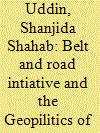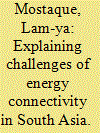|
|
|
Sort Order |
|
|
|
Items / Page
|
|
|
|
|
|
|
| Srl | Item |
| 1 |
ID:
170618


|
|
|
|
|
| Summary/Abstract |
Bangladesh Coast Guard (BCG) came into being in 1995. As the youngest law enforcing agency, it finds some difficulties in making required elbow room among other forces. In course of time, overlaps with other forces cropped up. BCG believes that the overlaps can be eliminated through clear demarcation of responsibilities and areas of jurisdiction. Besides, providing limited magistracy power at sea and making BCG the maritime service provider for other law enforcing agencies would strengthen the law enforcing efforts and save resources. On the other hand, BCG’s decision-making structure has a huge scope of deeper engagement towards obtaining better decisions for BCG. Placement of BCG officers in the ministry and establishing seamless communications with the decision-making structure are some of the measures to overcome this hindrance. Experiences of other coast guards across the globe also suggest similar steps. Towards building a more effective and efficient decision-making structure, ministry-BCG overlapping placements and engaging the decisionmakers more deeply can be suggested along with a few other measures. With these teething problems resolved, one believes that BCG would be in a far better position to become the true ‘Guardian at sea’. Keywords: Guardian at sea, BCG’s AOR, Overlapping Responsibility, Specialized Maritime Skills, Decision-making Structure Reform
|
|
|
|
|
|
|
|
|
|
|
|
|
|
|
|
| 2 |
ID:
170622


|
|
|
|
|
| Summary/Abstract |
This paper examines how China’s latest mega plan – the Belt and Road Initiative (BRI) will influence the geopolitics of energy. With a massive change in global energy supply and demand, the transition of international energy order is in the making. While the USA is going towards more isolationist path from its traditional superpower role, there are growing economies such as China, India, Japan and Russia which are undoubtedly playing important role on geopolitical stage. Several regions such as Central Asia, the Arctic, Eastern Mediterranean and South China Sea are offering huge natural gas and oil reserves and drawing global attention to develop energy cooperation. This situation is profoundly influencing the transition of energy order. In this transition, BRI is supposed to play an important role. As a mega development strategy with strong geostrategic dimension, it aims at promoting interconnectivity and cooperation in infrastructure, trade and development among the participating countries. This mega plan offers plenty of investments, infrastructure constructions and industrial integration in the energy sector. In addition, China is trying to build alternative energy shipping routes for evading heavy dependence on traditional energy chokepoints, specifically on the Strait of Malacca. In doing so, the country is trying to establish a multilateral platform for promoting and protecting energy cooperation under BRI. This paper, therefore, attempts to observe how this mega plan will contribute in re-shaping the existing energy order as well as the geopolitics of energy with a focus on multilateral energy cooperation.
|
|
|
|
|
|
|
|
|
|
|
|
|
|
|
|
| 3 |
ID:
170621


|
|
|
|
|
| Summary/Abstract |
Ensuring energy security has emerged as one of the key challenges all over the world. To meet that challenge, countries have resorted to increasing cooperation among themselves which resulted in many successful energy connectivity initiatives. In South Asia, countries are facing increasing energy demand with its rapid economic development. The concept of energy cooperation is not new in South Asia and countries have tried to initiate it through many regional and sub-regional forums. However, the success in implementing them has been very limited. This paper tries to understand why energy connectivity initiatives in South Asia has remained elusive. To that end, the paper conceptualizes energy connectivity and identifies enabling factors that help a n energy connectivity initiative. It finds that some of those factors are missing in South Asia, which is why implementing energy connectivity initiatives has been challenging and the challenges are often intertwined. The paper concludes by stressing that energy connectivity is vital for meeting the future energy needs of the region and countries should take a step by step approach to implement it.
|
|
|
|
|
|
|
|
|
|
|
|
|
|
|
|
| 4 |
ID:
170620


|
|
|
|
|
| Summary/Abstract |
The convergence of interests and shared sense of connectivity between Bangladesh and India have opened up potential of new business corridors between the former and the latter’s Northeast. But three states in that region, viz. Mizoram, Manipur and Nagaland are not engaging with Bangladesh like Tripura, Assam and Meghalaya; which needs to be addressed to unlock the potentials since both Bangladesh and Northeast India have been given importance in India’s ‘Act East Policy’. Enhancement of trade, investment, connectivity, energy, cultural exchanges, etc. are possible with seamless transport and communication network. The paper suggests that India’s Northeast serves as an easy source of raw materials and intermediate products for different industries in Bangladesh. Advanced infrastructural development with inland water connectivity, rail and road transportation will boost bilateral trade relations and open up more business opportunities with relatively less connected states of India’s Northeast.
|
|
|
|
|
|
|
|
|
|
|
|
|
|
|
|
| 5 |
ID:
170619


|
|
|
|
|
| Summary/Abstract |
The ‘Foreign Terrorist Fighter (FTF)’ phenomenon in contemporary time has got prominence since the inception of the Syrian Civil War in 2011. Thousands of different nationals especially from European countries travelled or made efforts to travel in war-torn Iraq and Syria to fight for the terrorist groups, predominantly the Islamic State (IS/Da’esh). It is argued that a bulk of the FTFs might have gone back to the countries of origin or home countries after the substantial loss of IS territory/Caliphate in Syria. The concern regarding the returnee FTFs assumed high priority on the political agenda of many Western countries for about last half a decade and stressed on a broad array of policies and strategies: policy on prevention of radicalization; information sharing and intelligence exchange; responses to returnees with criminal justice trial; deradicalization, rehabilitation, and reintegration with the mainstream population. However, the ‘Global Village’ is not immune from the menace and spillover effects of FTFs and the returnees. Thus, the present paper makes an effort to trace the universal response strategies against FTFs and the returnees including the associated families. It attempts to answer some fundamental questions, i.e., who are the foreign terrorist fighters? why do they go to foreign land to fight? and what are they likely to do when the fight is over? It furthermore examines how some of the affected countries have responded to the menace of FTFs and the returnees. The paper also argues that global communities are facing formidable challenges to counter the terrorist activities of FTFs and the returnees. Thus, there is a need to have a comprehensive approach to eliminate the risks eminating from contemporary FTF phenomenon.
|
|
|
|
|
|
|
|
|
|
|
|
|
|
|
|
|
|
|
|
|